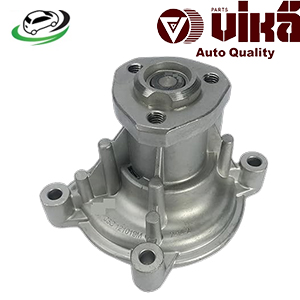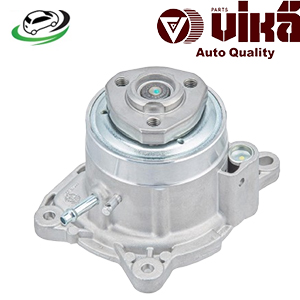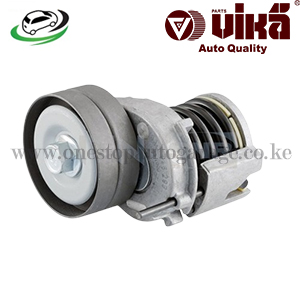-9%
Get Engine belt tensioner Assembly VW EOS 1F7/1F8 / VW Scirocco 1.4 TSI/1.2/1.6/ VW Caddy R32/GTI /Audi A3/S3 03C145299AC
The engine belt tensioner assembly is an essential component in a vehicle’s engine system, crucial for maintaining the proper tension on the serpentine or accessory belts. These belts drive various engine accessories such as the alternator, power steering pump, water pump, and air conditioning compressor. Understanding the function of the belt tensioner, recognizing signs of wear, and knowing how to maintain or replace it can help ensure that your engine runs smoothly and efficiently.
What is an Engine Belt Tensioner Assembly?
The engine belt tensioner assembly is a device that maintains the correct tension on the serpentine belt or accessory belts in an engine. This assembly typically includes a pulley, a spring or hydraulic mechanism, and a mounting bracket. The tensioner’s primary job is to keep the belt tight enough to prevent slipping while also accommodating changes in belt length due to wear or temperature fluctuations.
Benefits of the belt tensioner assembly
1. Maintains Optimal Belt Tension
The primary function of the belt tensioner assembly is to keep the serpentine belt or accessory belts at the correct tension. Proper tension ensures that the belt can effectively drive engine accessories like the alternator, power steering pump, water pump, and air conditioning compressor. By maintaining optimal tension, the tensioner helps to prevent belt slippage, which can lead to inefficient operation of these accessories.
2. Reduces Wear and Tear on the Belt
The tensioner compensates for the natural wear and stretching of the belt over time. As belts stretch, they can become loose, leading to slipping or poor performance of engine accessories. The tensioner adjusts to keep the belt tight, reducing excessive wear and extending the life of the belt. This helps avoid premature belt replacement and ensures consistent performance.
3. Minimizes Engine Vibration
A properly functioning belt tensioner helps to minimize engine vibration. Excessive vibration can be caused by a loose or improperly tensioned belt, which can lead to discomfort while driving and increased wear on engine components. By maintaining the correct tension, the tensioner helps to reduce vibration, leading to a smoother and quieter engine operation.
4. Prevents Belt Slippage
Belt slippage occurs when the belt is not properly tensioned and loses grip on the pulleys. This can lead to decreased performance of the engine accessories and potential damage to the belt itself. The tensioner ensures that the belt remains tightly in place, preventing slippage and ensuring that all driven accessories function correctly.
5. Enhances Engine Accessory Performance
Proper belt tension is crucial for the efficient operation of engine accessories. For example, if the alternator belt is too loose, the alternator may not charge the battery effectively. Similarly, a loose power steering belt can lead to difficulty in steering. By maintaining proper tension, the belt tensioner ensures that all accessories operate at their optimal performance levels, contributing to the overall functionality of the vehicle.
6. Reduces Maintenance and Repair Costs
A well-maintained belt tensioner assembly can help avoid more costly repairs and replacements. By preventing belt slippage, reducing excessive wear, and minimizing vibration, the tensioner helps to prolong the life of the serpentine belt and other engine components. This reduces the likelihood of frequent belt replacements and associated labor costs, leading to lower overall maintenance expenses.
7. Improves Fuel Efficiency
When the serpentine belt is properly tensioned, it ensures that engine accessories operate efficiently without unnecessary drag on the engine. This can contribute to better fuel efficiency, as the engine does not have to work harder to drive the accessories. Improved efficiency can lead to reduced fuel consumption and better overall performance.
8. Provides Consistent Engine Operation
A functioning belt tensioner contributes to consistent engine operation by ensuring that the belt remains properly tensioned. Consistent tension helps to prevent issues such as erratic accessory performance or unexpected failures, leading to a more reliable driving experience. This consistency is especially important for modern vehicles that rely on precise accessory operation for optimal performance.
9. Facilitates Smooth Engine Start-Up
A properly adjusted belt tensioner helps to ensure smooth engine start-up by maintaining the correct belt tension. This can prevent issues such as belt slippage or accessory drag that might occur during engine start-up. Smooth start-ups contribute to overall vehicle reliability and reduce the risk of engine-related problems.
10. Supports Long-Term Engine Health
Overall, the belt tensioner assembly supports long-term engine health by keeping the serpentine belt at the correct tension and preventing potential issues related to belt slippage, wear, and vibration. This contributes to the longevity of the engine and its accessories, leading to fewer problems and more reliable vehicle performance over time.
Types of Belt Tensioners
There are two main types of belt tensioners used in vehicles:
- Spring-Loaded Tensioners: These are the most common type of belt tensioners. They use a spring to apply tension to the belt. The spring is calibrated to provide the correct amount of tension and compensates for belt stretch. As the belt wears and stretches, the tensioner adjusts its position to maintain proper tension.
- Hydraulic Tensioners: Hydraulic tensioners use a hydraulic piston to maintain belt tension. These are often found in modern vehicles with more advanced engine designs. The hydraulic mechanism allows for more precise tension adjustment and can handle higher belt loads.
Signs of a Failing Belt Tensioner
A failing belt tensioner can lead to various issues, including poor performance of engine accessories and potential damage to the belt and other components. Here are some common signs that your belt tensioner may be failing:
- Belt Slippage or Squealing Noise: If you hear a squealing noise coming from the engine, it could be a sign that the belt is slipping due to insufficient tension. This noise is often more noticeable when the engine is first started or during acceleration.
- Erratic Belt Movement: A failing tensioner may cause the belt to move erratically or bounce. This can be seen visually or felt as a vibration when driving.
- Increased Engine Vibration: If the engine feels unusually rough or vibrates more than usual, it could be due to a worn-out tensioner. A tensioner that doesn’t maintain proper tension can lead to excessive vibration and wear on engine components.
- Belt Wear or Cracking: Inspecting the belt itself can reveal signs of wear or cracking. If the belt appears worn out, it could be due to a failing tensioner not maintaining the correct tension.
- Warning Lights or Dashboard Alerts: Some vehicles have sensors that monitor the belt tension and can trigger warning lights or dashboard alerts if there’s a problem with the tensioner or the belt.
Maintaining the Engine Belt Tensioner
Proper maintenance of the belt tensioner can help extend its life and ensure that your engine runs smoothly. Here are some tips for maintaining the tensioner:
- Regular Inspections: Periodically inspect the tensioner and the serpentine belt for signs of wear or damage. Look for any visible issues with the tensioner pulley, such as cracks or excessive movement.
- Check for Proper Tension: Ensure that the belt is properly tensioned. Most vehicles have a specification for the correct tension, which can be checked using a tension gauge or by consulting the vehicle’s service manual.
- Listen for Unusual Noises: Pay attention to any unusual noises coming from the engine, such as squealing or rattling. These noises can indicate a problem with the tensioner or the belt.
- Follow the Maintenance Schedule: Adhere to the vehicle manufacturer’s recommended maintenance schedule for replacing the serpentine belt and inspecting the tensioner. Regular maintenance can help prevent issues before they become major problems.
Replacing the Engine Belt Tensioner
If you suspect that your belt tensioner is failing, it’s important to replace it promptly to avoid damage to the belt and other engine components. Here’s a general guide to replacing the belt tensioner:
- Preparation: Start by gathering the necessary tools, including a wrench or socket set, and a new belt tensioner. Make sure the engine is cool before you begin working.
- Remove the Serpentine Belt: Use a wrench or socket to relieve the tension on the belt tensioner and remove the serpentine belt from the pulleys.
- Remove the Old Tensioner: Locate the bolts that secure the old tensioner to the engine. Remove these bolts and take out the old tensioner. Be careful to note the position and orientation of the tensioner for proper installation of the new one.
- Install the New Tensioner: Position the new tensioner in place and secure it with the bolts. Make sure it’s properly aligned and tightened according to the manufacturer’s specifications.
- Reinstall the Serpentine Belt: Place the serpentine belt back onto the pulleys, ensuring it’s properly aligned with all the pulleys. Use the wrench or socket to apply tension to the new tensioner and secure the belt.
- Check the Belt Tension: Verify that the belt is properly tensioned and that it’s running smoothly on all the pulleys. Start the engine and check for any unusual noises or issues.
- Test Drive: After installation, take the vehicle for a test drive to ensure that the new tensioner is working correctly and that the engine accessories are functioning properly.
Follow us on Facebook for more parts.





